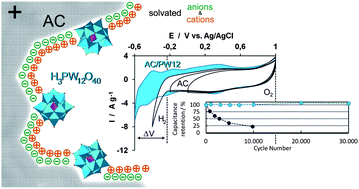Hybrid energy storage: high voltage aqueous supercapacitors based on activated carbon–phosphotungstate hybrid materials†
Abstract
The use of hybrid electrodes prepared from phosphotungstic acid (H3PW12O40, PW12) and activated carbon (AC) allows the fabrication of highly durable aqueous supercapacitors operating at a superior voltage (1.6 V) thanks to the high overpotential of PW12 towards H2 generation. The combination of the double-layer capacitance plus the redox activity of the polyoxometalate clusters leads to an intrinsic increase in specific capacitance (from 185 F g−1 for AC to 254 F g−1 for AC–PW12) and a 60% increase in the operating voltage (compared to conventional AC supercapacitors with aqueous electrolytes, e.g. 1 M sulphuric acid). The hybrid energy storage mechanism and the increased operating voltage converge to yield improved specific energy and power. Moreover, the hybrid AC–PW12 electrode material showed an outstanding stability even after 30 000 cycles (0 to 1.6 V) with 98% retention of the initial capacitance, much superior to the stability of the parent supercapacitor based on plain AC under the same conditions.


 Please wait while we load your content...
Please wait while we load your content...